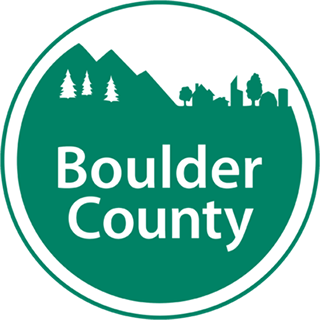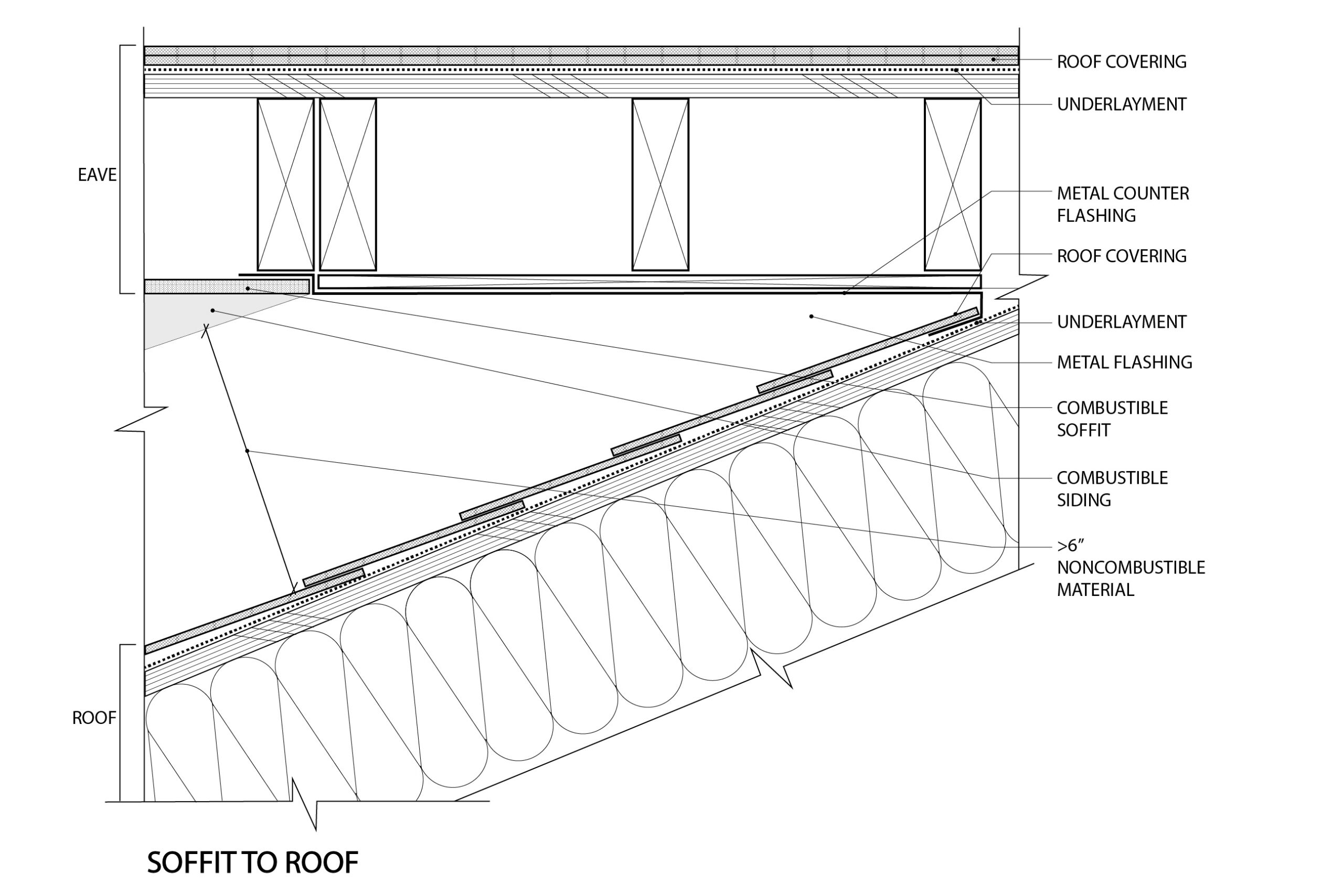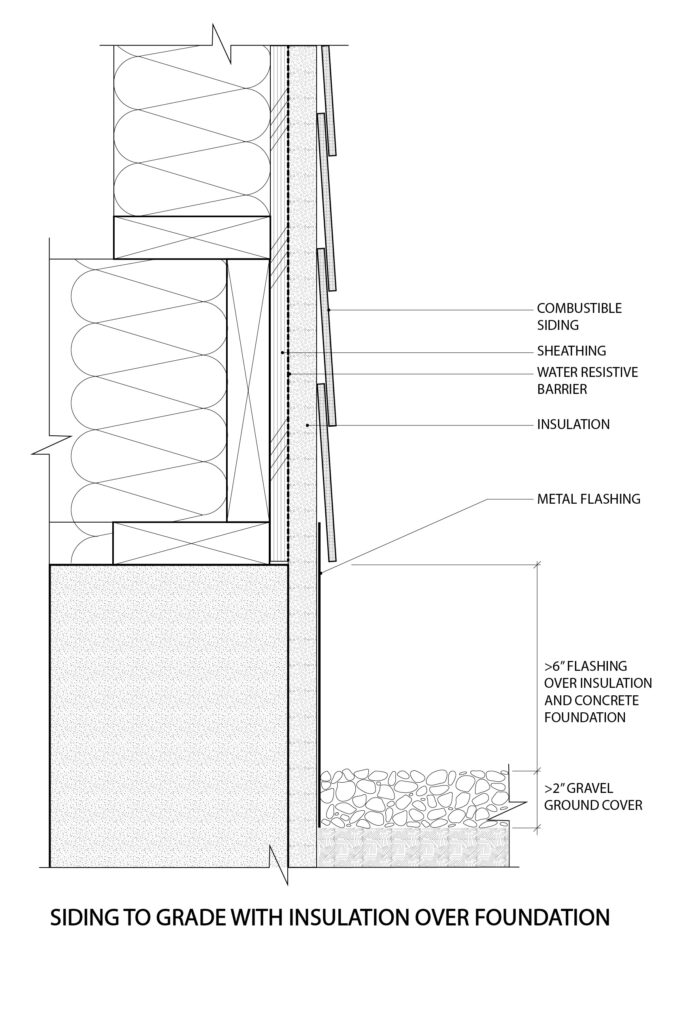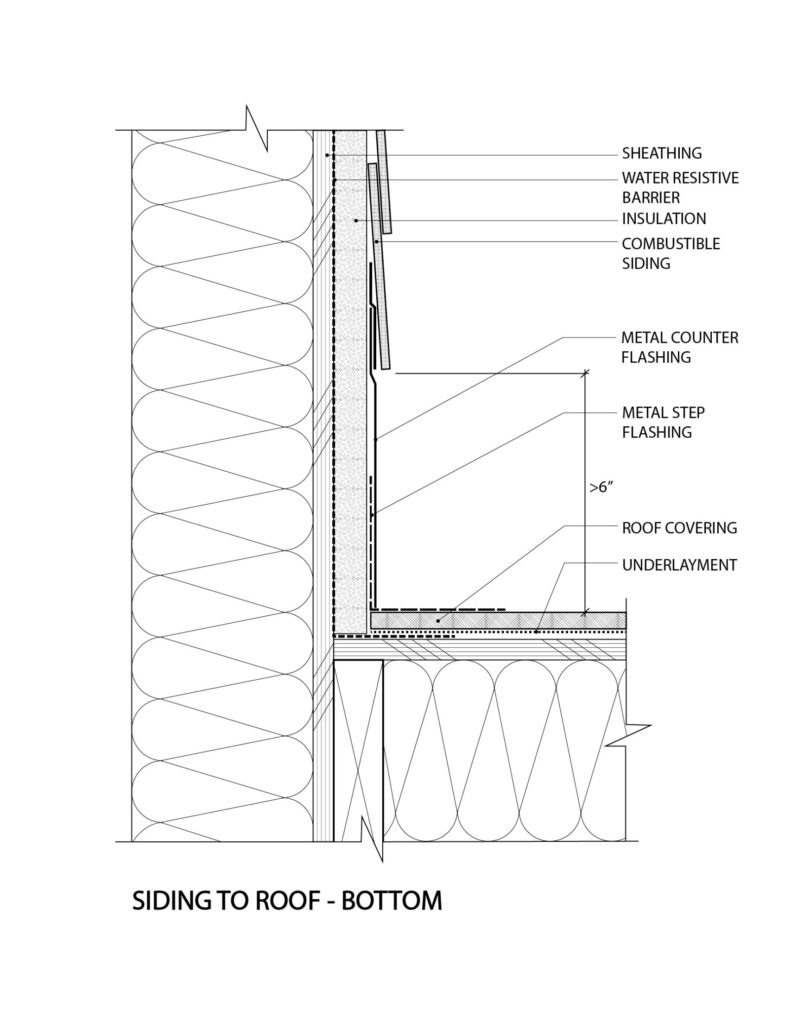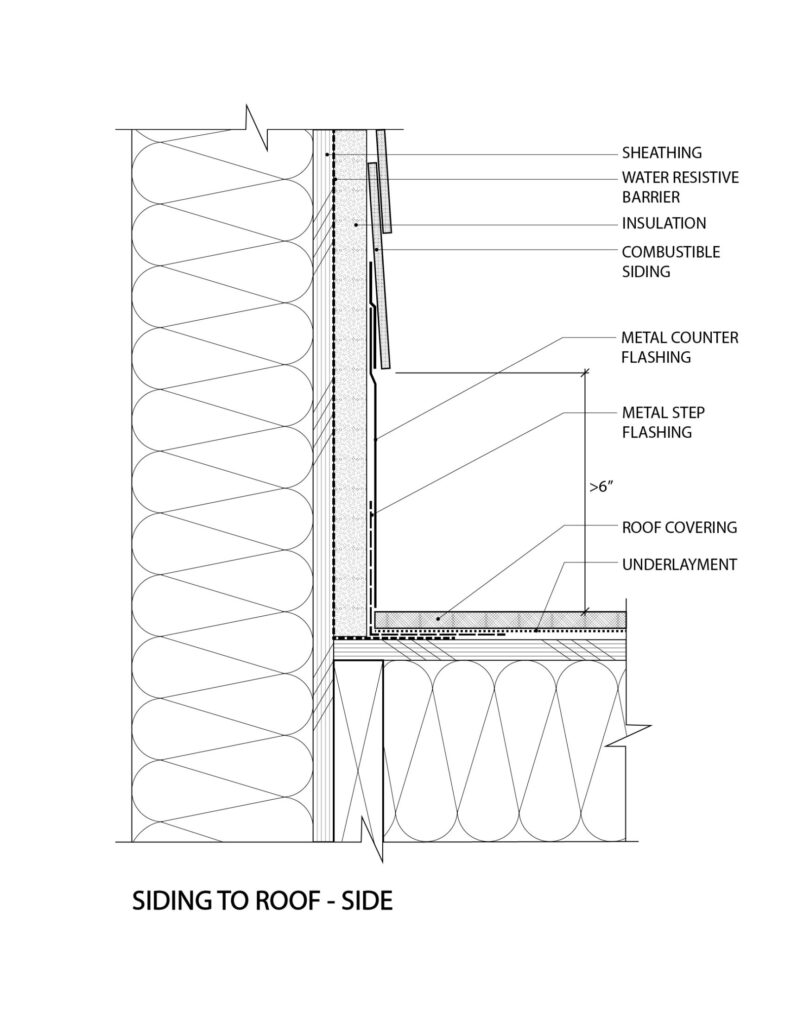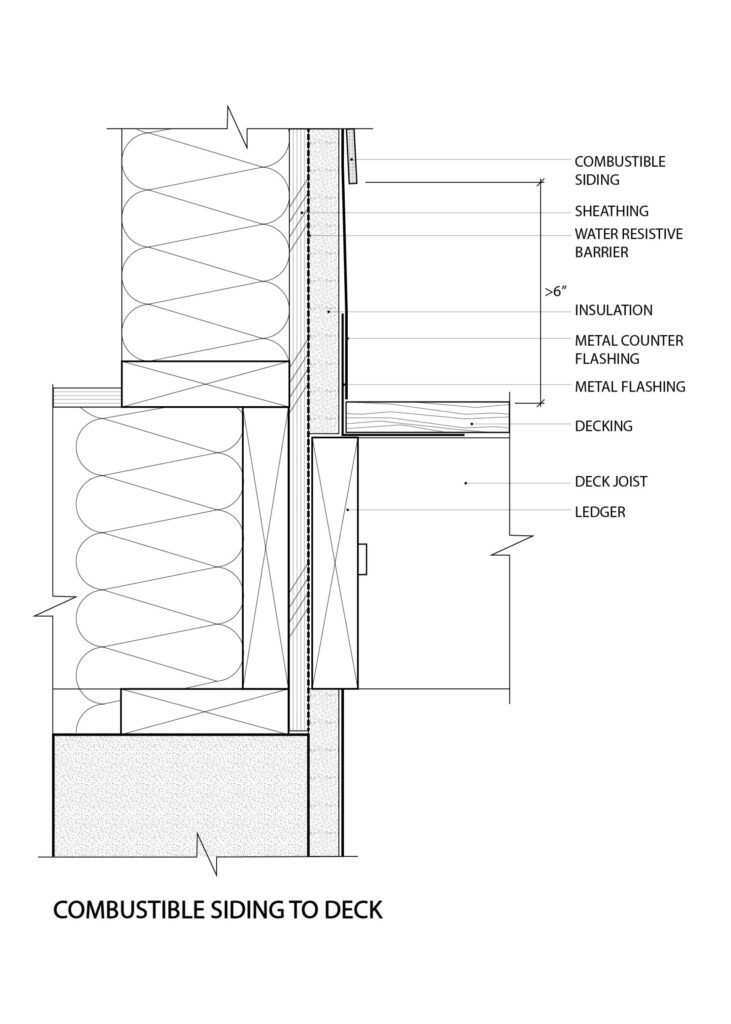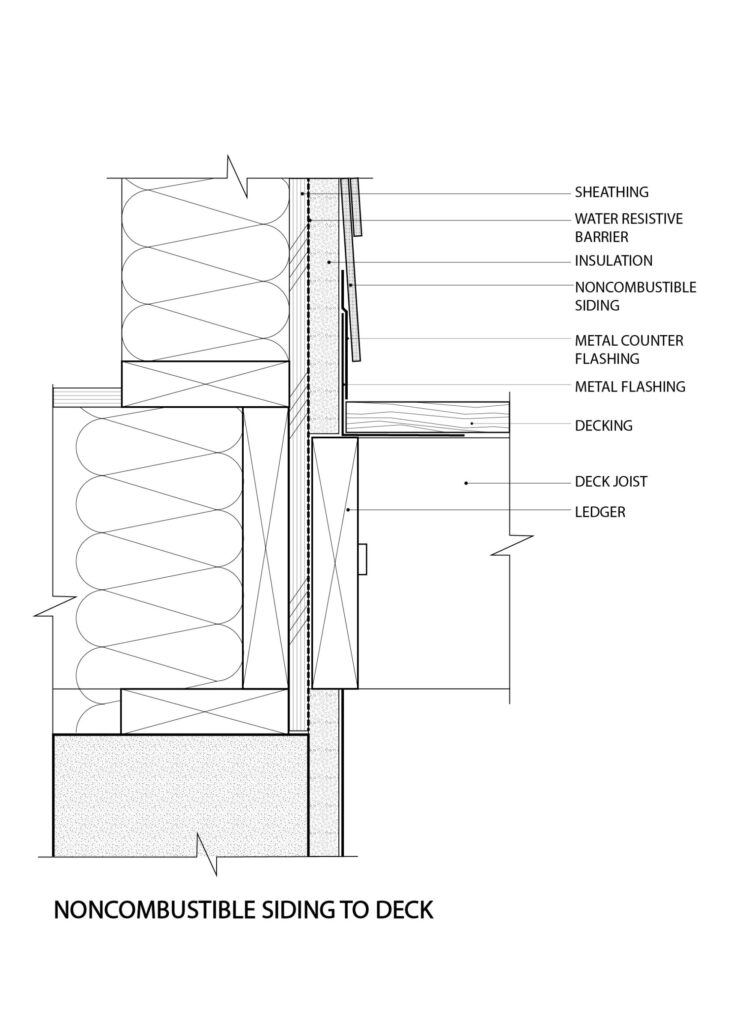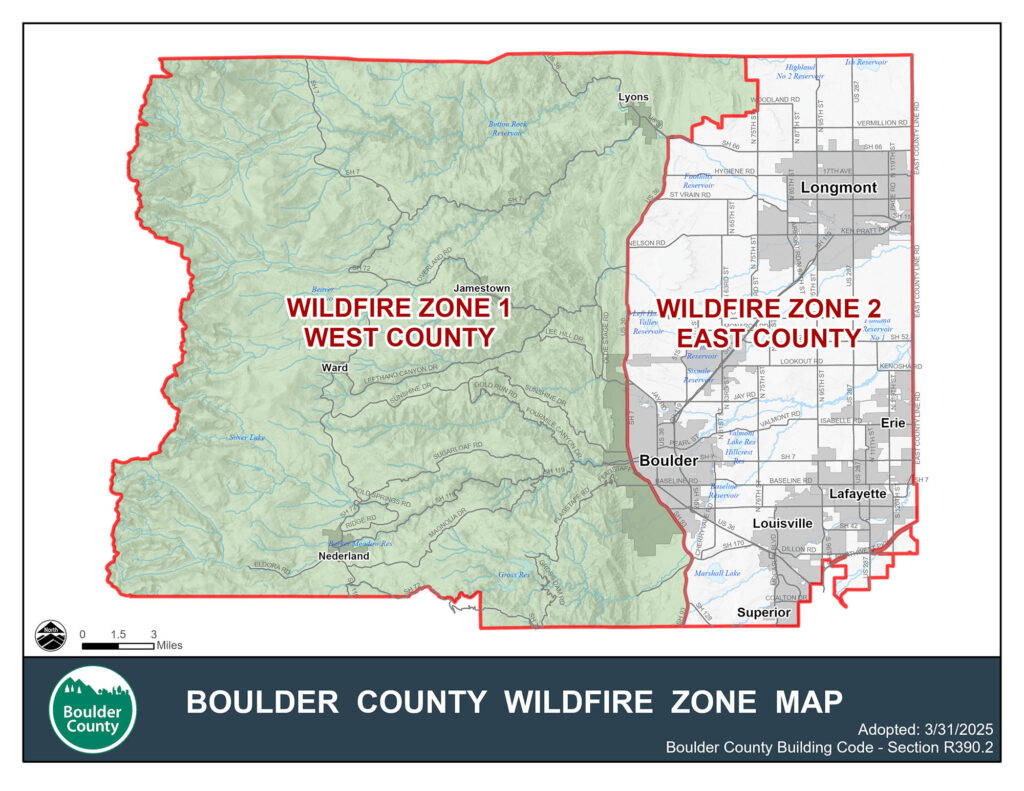Boulder County’s Building Publication B-37 outlines ignition-resistant construction requirements for new projects and remodels in Wildfire Zones 1 and 2, detailed in Section R390 of the 2021 Boulder County Building Code Amendments. For building permits applied for under the 2015 code, property owners should consult the 2015 Boulder County Building Code Amendments:

Boulder County Building Publications
Ignition Resistant Construction - B37
R390.1 Requirements based on locations in wildfire zones
R390.1.1 General
Unless other more restrictive requirements, such as those requiring an approved wildfire mitigation plan imposed through Site Plan Review or other review processes required by the Boulder County Land Use Code, apply, this section shall be applicable to all new buildings, additions, alterations, and repairs, including buildings designed and constructed in accordance with the International Building Code® and International Wildland-Urban Interface Code.
Exceptions:
-
- One-time additions not exceeding 200 square feet in floor area.
- Accessory structures not exceeding 120 square feet (11 m2) in floor area located not less than 50 feet (15 240 mm) from buildings containing habitable spaces.
- Agricultural buildings not exceeding 200 square feet (18.58 m2) not less than 50 feet (15 240 mm) from buildings containing habitable spaces.
R390.2 Wildfire Zones Defined
For the purpose of this code, the unincorporated portion of Boulder County is divided into wildfire zones, which shall be known and designated as Wildfire Zone 1-West County and Wildfire Zone 2-East County. The wildfire zones shall include such territory or portions of the unincorporated county as shown in Figure R390.2, the Wildfire Zone Map.
R390.2.1 Buildings Located in More Than One Wildfire Zone
A building or structure that is located partly in one wildfire zone and partly in another shall be considered to be in the wildfire zone in which the more restrictive conditions apply.
R390.2.2 Moved Buildings
Any building or structure moved within or into any wildfire zone shall be made to comply with all the requirements for new buildings in that wildfire zone.
R390.3 Definitions
The following words and terms shall, for the purpose of this Section, have the meanings shown herein.
Defensible Space
An area either natural or manmade, where material capable of allowing a fire to spread unchecked has been treated, cleared or modified to slow the rate and intensity of an advancing wildfire and to create an area for fire suppression operations to occur.
Defensible Space Standard
The Colorado State Forest Service publication, Protecting Your Home from Wildfire: Creating Wildfire-Defensible Zones, 2012 Quick Guide is an approved standard for meeting the defensible space requirements of Section R390.4.12 or for the creation of a wildfire mitigation plan.
Fire Retardant Treated Wood
Wood products that, when impregnated with chemicals by a pressure process or other means during manufacture, exhibit reduced surface-burning characteristics and resist propagation of fire, as defined in IBC 202 and IRC R202. Wood meeting the requirements of Section R802.1.5 of the International Residential Code® or Section 2303.2 of the International Building Code®.
Heavy Timber Construction (Type IV, HT)
Construction with wood framing members, columns, flooring and roof decks sized in accordance with International Building Code® Section 602.4.
Ignition-Resistant Building Material
Ignition-resistant building materials shall comply with any one of the following:
1. Extended ASTM E 84 testing. Material shall be tested on all sides with the extended ASTM E 84 (UL 723) test or ASTM E 2768, except panel products shall be permitted to test only the front and back faces. Panel products shall be tested with a ripped or cut longitudinal gap of 1/8 inch (3.2 mm). Materials that, when tested in accordance with the test procedures set forth in ASTM E 84 or UL 723 for a test period of 30 minutes, or with ASTM E 2768, comply with the following:
1.1 Flame spread. Material shall exhibit a flame spread index not exceeding 25 and shall not show evidence of progressive combustion following the extended 30-minute test.
1.2 Flame front. Material shall exhibit a flame front that does not progress more than 10-½ feet (3200 mm) beyond the centerline of the burner at any time during the extended 30-minute test.
1.3 Weathering. Ignition-resistant building materials shall maintain their performance in accordance with this Section under conditions of use. Materials shall meet the performance requirements for weathering (including exposure to temperature, moisture and ultraviolet radiation) contained in the following standards, as applicable to the materials and the conditions of use:
1.3.1 Method A “Test Method for Accelerated Weathering of Fire-Retardant-Treated Wood for Fire Testing” in ASTM D 2898, for fire-retardant-treated wood, wood-plastic composite, and plastic lumber materials.
1.3.2 ASTM D 7032 for wood-plastic composite materials.
1.3.3 ASTM D 6662 for plastic lumber materials.
1.4 Identification. All materials shall bear identification showing the fire test results.
Exception:
Materials comprised of a combustible core and a noncombustible exterior covering, comprised of either aluminum at a minimum 0.019-inch (0.48 mm) thickness or corrosion-resistant steel at a minimum 0.0149-inch (0.38 mm) thickness shall not be required to be tested with a ripped or cut longitudinal gap.
2. Noncombustible material. Material that complies with the requirements for noncombustible materials in this section, including but not limited to approved materials as follows:
2.1 Cementitious stucco
2.2 Cementitious cladding
2.3 Metal sheeting comprised of either aluminum at a minimum 0.019-inch (0.48 mm) thickness or corrosion- resistant steel at a minimum 0.0149-inch (0.38 mm) thickness.
3. Fire-retardant-treated wood. Fire-retardant-treated wood labeled for exterior use. Where a section also specifies fire-retardant-treated wood with a dimensional thickness, the specified dimension at a minimum is required.
Log Wall Construction
A type of construction in which exterior walls are constructed of solid wood members and where the smallest horizontal dimension of each solid wood member is at least 6-inches (152 mm).
Multilayered Glazed Panels
Window or door assemblies that consist of two or more independently glazed panels installed parallel to each other, having a sealed air gap in between, within a frame designed to fill completely the window or door opening in which the assembly is intended to be installed.
Noncombustible
As applied to building construction material means a material that, in the form in which it is used, is either one of the following:
-
- Material of which no part will ignite and burn when subjected to fire. Any material conforming to ASTM E 136 shall be considered noncombustible within the meaning of this Section.
- Material having a structural base of noncombustible material as defined in Item 1 above, with a surfacing material not over 1/8 inch (3.2 mm) thick, which has a flame spread index of 50 or less. Flame spread index as used herein refers to a flame spread index obtained according to tests conducted as specified in ASTM E 84 or UL723.
“Noncombustible” does not apply to surface finish materials. Material required to be noncombustible for reduced clearances to flues, heating appliances or other sources of high temperature shall refer to material conforming to Item 1. No material shall be classified as noncombustible that is subject to increase in combustibility or flame spread index, beyond the limits herein established, through the effects of age, moisture or other atmospheric condition.
Wildfire Mitigation Plan
A wildfire mitigation plan addresses the risk of wildfire both to the subject property and those posed to neighboring properties in the surrounding area by the proposed development through appropriate site location for structures, construction design and the use of ignition-resistant building material, defensible space and fuel reduction around structures, driveway access for emergency vehicles and an emergency water supply for firefighting in accordance with Article 4-804(C.)(12.) and Article 4-806(A.)(5.) of the Boulder County Land Use Code.
Wildfire Partners
Wildfire Partners is a collaborative Boulder County wildfire hazard mitigation program for homeowners that helps to reduce the risk of damage to homes from wildland fire. In Wildfire Partners, homeowners take personal responsibility for preparing their home and property for wildland fire and actively participate in an onsite assessment with a wildfire mitigation specialist. When participants complete their customized wildfire mitigation plan and pass their follow up inspection, they receive a Wildfire Partners Certificate and may be eligible for financial assistance (www.wildfirepartners.org).
R390.4 Restrictions in Wildfire Zones
Individual buildings or structures constructed in Wildfire Zone 1-West County and Wildfire Zone 2-East County shall comply with this section.
R390.4.1 Roof covering
Roofs shall have a roof assembly that complies with a Class A rating when tested in accordance with ASTM E108 or UL 790.
Exceptions:
-
- Class A roof assemblies include those with coverings of brick, masonry or an exposed concrete roof deck.
- Class A roof assemblies also include ferrous or copper shingles or sheets, metal sheets and shingles, clay or concrete roof tile or slate installed on noncombustible decks or ferrous, copper or metal sheets installed without a roof deck on noncombustible framing.
- Class A roof assemblies include minimum 16 ounce per square foot (0.0416 kg/ m2) copper sheets installed over combustible decks.
- Class A roof assemblies include slate installed over ASTM D226, Type II underlayment over combustible decks.
For roof coverings where the profile allows a space between the roof covering and roof decking, the space at the eave ends shall be fire stopped to preclude entry of flames or embers, or have one layer of 72-pound (32.4 kg) mineral- surfaced, non-perforated cap sheet complying with ASTM D 3909 installed over the combustible decking.
R390.4.1.1 Roof valleys
When provided, valley flashings shall be not less than 0.019-inch (No. 26 galvanized sheet gauge) corrosion-resistant metal installed over a minimum 36-inch (914 mm) wide underlayment consisting of one layer of 72-pound mineral- surfaced, non-perforated cap sheet complying with ASTM D 3909 running the full length of the valley.
R390.4.1.2 Light transmitting plastics in roof installations
In all Wildfire Zones, light-transmitting plastics, including thermoplastic, thermosetting or reinforced thermosetting plastic material, shall conform to the Class CC1 combustibility classification referenced in the International Building Code® section 2606.4.
R390.4.2 Gutters and downspouts
Gutters, downspouts, and gutter covering devices shall be constructed of noncombustible material. Gutters shall be provided with an approved means to prevent the accumulation of leaves, pine needles and debris in the gutter. Where downspouts, gutters and/or gutter guards are replaced or installed they shall be of noncombustible material.
Exceptions:
-
- Buildings meeting one of the exceptions to International Residential Code Section R401.3.1 and International Building Code 1804.4 of this code may be constructed without gutters and downspouts.
- Structures where gutter guards have not been previously installed and a reroof is performed, do not require gutter guards to be installed.
R390.4.3 Spark arrestors
Chimneys serving fireplaces, barbecues, incinerators or decorative heating appliances in which solid or liquid fuel is used shall be protected with a spark arrester. Spark arresters shall be constructed of woven or welded wire screening of 12 USA standard gauge wire (0.1046 inch)(2.66 mm) having openings not exceeding 1/2-inch (12.7 mm). The net free area of the spark arrester shall not be less than four times the net free area of the outlet of the chimney.
R390.4.4 Fences, retaining walls and similar appurtenances
Fences, retaining walls or other appurtenances that connect to buildings must be constructed of noncombustible materials or ignition-resistant materials for a distance of 5-feet beyond the exterior walls.
R390.4.5 Overhanging projections
All exterior projections including, but not limited to, exterior balconies, carports, decks, patio covers, porch ceilings, unenclosed roofs and floors, overhanging buildings and similar architectural appendages and projections shall be protected as specified in this section.
R390.4.5.1 Exterior open covers, patio covers, porch ceilings, roof eaves, soffits and cornices
The exposed underside of exterior patio ceilings, porch ceilings, rafter or truss eaves, soffits, and cornices shall be protected by one of the following:
-
-
- Noncombustible material.
- Ignition-resistant material.
- Heavy timber construction.
- 3/4-inch-thick nominal fire retardant-treated plywood labeled for exterior use.
- Any approved inherently noncombustible material as defined by the NFPA, with approved defensible space within 12-feet (3658 mm) above grade.
-
Exception:
Rafter tails or roof beam ends may be exposed if they are heavy timber having minimum dimensions not less than 6- inch (152 mm) nominal in width and not less than 8-inches (203 mm) nominal in depth.
R390.4.5.1.1 Protection of fascia
The leading edge of the roof at the fascia must be finished with a metal drip edge so that no wood sheathing is exposed.
R390.4.5.1.2 Soffits and eaves extending over horizontal surfaces
“Combustible materials” (materials not considered noncombustible), including wood products, are not allowed to be installed within 6-inches (152 mm) of a horizontal surface, including but not limited to dormer roof eaves, roof eaves that extend over grade or decks, and areas where embers may accumulate within 6-inches (152 mm) of the eave.
Noncombustible materials shall be used on soffits and eaves within 6-inches (152 mm) of an adjacent horizontal and sloped surface, including grade, deck, or roof construction.
R390.4.5.2 Floor projections including unenclosed under floor protection 12 feet or less above finished grade
Buildings or structures shall have all underfloor areas enclosed to the ground with exterior walls in accordance with Section R390.4.6. For decks, see Section R390.4.8.
Exception:
Complete enclosure of floor projections and unenclosed floor areas exposed to the exterior may be omitted the exposed underside of cantilevered floor projections and exposed, unenclosed floor areas less than 12 feet (3658 mm) above grade or the surface, measured at any portion below, are protected by one of the following:
-
-
- Heavy timber construction.
- 3/4-inch (19.0 mm) thick nominal fire retardant-treated plywood labeled for exterior use.
- One layer of 5/8-inch (15.9 mm) Type X exterior gypsum sheathing applied behind an exterior covering on the underside of the floor projection. Where finish materials are applied to the surface, those materials must be ignition resistant.
- The exterior portion of a 1-hour fire-resistance-rated exterior assembly, as tested in accordance with ASTM E119 or UL 263, applied to the underside of the ceiling, roof ceiling or floor/ceiling, assembly, including assemblies using the gypsum panel and sheathing products listed in the Gypsum Association Fire Resistance Design Manual. Where finish materials are applied to the surface, those materials must be ignition resistant.
- Materials approved for not less than 1-hour fire resistance-rated construction on the exterior side, as tested in accordance with ASTM E119 or UL 263. Where finish materials are applied to the surface, those materials must be ignition resistant.
-
R390.4.5.3 Floor projections including unenclosed under floor protection 200 square feet or less in area or greater than 12 feet above finished grade
Buildings or structures shall have all underfloor areas enclosed to the ground with exterior walls in accordance with Section R390.4.6. For decks, see Section R390.4.8.
Exception:
Complete enclosure of floor projections and unenclosed floor areas exposed to the exterior may be omitted where the exposed underside of cantilevered floor projections and exposed, unenclosed floor areas greater 12 feet (3658 mm) above grade or the surface, measured at any portion below, are protected by one of the following:
-
-
- Any method listed in R390.4.5.2.
- Noncombustible material.
- Ignition-resistant material.
- Heavy timber construction.
- 3/4-inch-thick nominal fire retardant-treated plywood labeled for exterior use.
- Any inherently noncombustible material as defined by the NFPA.
-
R390.4.6 Exterior walls
Exterior walls of buildings or structures shall be constructed with one of the following methods:
-
- Approved noncombustible materials.
- Heavy timber construction or log wall construction.
- Fire-retardant-treated wood labeled for exterior use on the exterior side.
- Ignition-resistant materials on the exterior side.
- Such material shall extend from the top of the foundation to the underside of the roof sheathing.
“Combustible materials” are materials not considered noncombustible, including wood products, are not allowed to be installed within 6-inches (152 mm) of a horizontal surface that extends 6-inches (152 mm) from the vertical plane of the wall. Noncombustible materials shall be used on walls within 6-inches (152 mm) of an adjacent horizontal surface, including grade, deck, or roof construction.
Exception:
Trim is not required to meet the materials requirements for exterior walls, where installed more than 6-inches (152 mm) above grade, floor, deck, or roof where wall abuts the horizontal surface.
R390.4.6.1 The base of exterior walls
The base of exterior walls, posts or columns shall be protected on the bottom side with provisions such as metal flashing or wire mesh having openings no larger than 1/8-inch (3.2 mm) to protect them from ember intrusion and still allow for weeping and moisture control.
R390.4.7 Reserved
R390.4.8 Decks, appendages, and projections
Decks and other unenclosed accessory structures attached to buildings shall be constructed of the following materials:
R390.4.8.1 Deck surface:
Noncombustible material, approved wood thermoplastic composite lumber with an ASTM E84 flame spread index no greater than 200, ignition-resistant building materials, or any approved Class A roof assembly.
R390.4.8.2 Deck framing:
Deck framing shall be constructed of one of the following:
-
-
- Metal
- Heavy timber construction.
- Approved noncombustible materials.
- Fire-retardant-treated wood labeled for exterior use.
- Ignition-resistant building materials.
- Wood with a minimum nominal thickness of at least 2-inches for joists and 2-2x members for beams and columns or posts, fastened tightly together.
-
R390.4.8.3 Deck Rails:
Horizontal deck rails and guard rails shall be constructed of materials allowed under R390.4.8.1 and R390.4.8.2 where within 5-feet of the exterior walls.
R390.4.8.4 Decks less than 4 feet above finished grade
Decks that are less than 4 feet to the deck walking surface shall be enclosed with noncombustible corrosion-resistant mesh with openings not to exceed 1/8 inches, or other approved materials. Enclosure shall not restrict clearance required for emergency escape and rescue openings required in IRC section R310 and IBC section 1031. The area beneath the deck shall be cleared of vegetation, debris, building materials, and combustible storage.
R390.4.8.5 Pergolas and similar construction
Pergola framing shall be constructed of one of the following:
-
-
- Metal
- Heavy timber construction.
- Approved noncombustible materials.
- Fire-retardant-treated wood labeled for exterior use.
- Ignition-resistant building materials.
- Wood with a minimum nominal thickness of at least 2-inches for joists and 2-2x members for beams and columns or posts, fastened tightly together.
-
R390.4.9 Exterior windows and glazing
Exterior windows, window walls, glazed doors, windows within exterior doors, and skylights shall be tempered glass, multilayered glazing, glass block, or have a fire protection rating of not less than 20 minutes. Unless they are part of a fire-rated assembly, window frames and sashes may be of any material permitted by this code.
Exception:
-
- Windows with unreinforced vinyl frames or sashes are not permitted.
- Individual buildings or structures on a property located in Wildfire Zone 2-East County are not required to comply with R390.4.9.
R390.4.10 Exterior doors
Exterior doors and garage doors shall be approved noncombustible construction, metal clad, solid core wood not less than 1-3/4 inches in thickness, or have a fire protection rating of not less than 20 minutes. Windows within doors and glazed doors shall be in accordance with Section R390.4.9.
Exception:
-
- Vehicle access doors.
- Individual buildings or structures on a property located in Wildfire Zone 2-East County are not required to comply with R390.4.10.
R390.4.11 Vents
Where provided, ventilation openings for enclosed attics, gable ends, ridge ends, under eaves and cornices, enclosed eave soffit spaces, enclosed rafter spaces formed where ceilings are applied directly to the underside of ceilings are applied directly to the underside of roof rafters, underfloor ventilation, foundations and crawl spaces, or any other opening intended to permit ventilation, either in horizontal or vertical surface, including but not limited to rain screens, shall be in accordance with Section R390.4.11.1 or section R390.4.11.2 to resist building ignition from the intrusion of burning embers and flame through the ventilation openings.
R390.4.11.1 Performance requirements
Ventilation openings shall be fully covered with listed vents tested in accordance with ASTM E2886, to demonstrate compliance with all of the following requirements.
-
-
- There shall be no flaming ignition of cotton material during the Ember Intrusion Test.
- There shall be no flaming or ignition during Integrity Test portion of the Flame Intrusion Test.
- The maximum temperature of the unexposed side of the vent shall not exceed 662 deg F.
-
R390.4.11.2 Prescriptive requirements
Where provided, attic ventilation openings, foundation or underfloor vents, or other ventilation openings vertical or horizontal surfaces and vents through roofs shall not exceed 144 square inches each. Such vents shall be covered with noncombustible corrosion resistant mesh with openings not to exceed 1/8-inch (3.2 mm) or shall be designed and approved to prevent flame or ember penetration into the structure.
R390.4.12 Defensible space
Individual buildings or structures on a property must be provided with a fuel modification zone in accordance with the defensible space standard. When additions requiring a permit occur, both existing and new structures must be provided with defensible space in accordance with this section. The fuel modification zone must be maintained at all times.
Exceptions:
-
- The implementation and completion of an approved wildfire mitigation plan prior to final inspection approval for the project.
- Participation in the Wildfire Partners program and the issuance of a Wildfire Partners certificate prior to final inspection approval for the project.
- Individual buildings or structures on a property located in Wildfire Zone 2-East County are not required to comply with defensible space standard, but must comply with R390.12.1.
- In Wildfire Zone 1-West County, construction limited to new covered projections, porches, decks, or repairs to existing decks shall adhere solely to the requirements of Defensible Space Management Zone 1 per the defensible space standard. Furthermore, a weed barrier and gravel must be installed on all sides of the construction in accordance with Section R390.4.12.1.
R390.4.12.1 Weed barrier and gravel or crushed rock specific
A weed barrier and gravel or crushed rock not less than 3/4-inch in diameter applied at least 2-inches thick must be installed beneath decks, unenclosed floors, and around the perimeter of the building to extend at least 5-feet beyond the exterior walls and at least 2-feet beyond the driplines of decks, bay windows and other eaves and overhangs.
Exception:
Noncombustible surfaces, such as poured concrete or asphalt, or other approved noncombustible materials, such as a weed barrier and brick, concrete or stone pavers, may be used to satisfy this requirement.
This Publication is Printable
